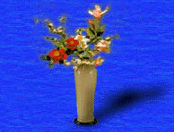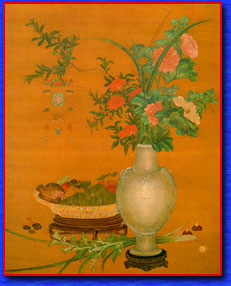



- Lo Chiu of the Tang Dynasty formulated nine principles which he observed
when producing floral compositions with the peony. They included: use of
a screen, a golden knife for cutting and trimming, spring water, jade vessel,
a decorative base, a brush-painting scroll as back- ground, good music,
fine wine, and spontaneously composed poetry. As the Tang Dynasty progressed
these simple principles were organized into more elaborate guidelines.
These included:
- 1 .) Flower containers and implements. Flowers were to be kept in a
container of the highest quality porcelain; the vase base and mounting
table were to be exquisitely carved; the knife used for trimming must be
especially .sharp and inlaid with gold designs; and the water in which
the flowers are kept must be fresh rain water or drawn from a natural spring.
- 2 .) The environment in which the flowers are grown. It was important
that flowers have sufficient air to breathe yet not be exposed to a strong
wind or breeze. For this purpose a decorative screen was erected around
flowers on display and, for decorative effect, a famous painting or piece
of calligraphy was placed in the background.
- 3.) Viewing flower arrangements. This was generally done to the singing
of songs or the recitation of poems which, ideally, had been composed on
the spot. The enjoyment was heightened by the serving of good mellow wine.
- Flower selection. Besides the nine simple principles described above,
Lo Chin preferred certain types of flowers to serve as complements to the
peony. These were the orchid, mei flower, and the lotus. On the other hands,
the hibiscus, rhododendron, wild plants, and weeds were to be avoided at
all cost.

[preface] [
styles] [religious] [palace]
[literati] [folk]
[9 pricniples] [significance]
[preveration] [vessels]
[appreciatin] [Pavilion
of Taiwan, R.O.c] [Cultures]
[Council For Cultural
Planning & Development]

![]()



![]()


![]()